Becoming a freelancer seems like an impossible pipe dream for many people.
But imagine being able to set your own schedule day-in and day-out and only doing work you absolutely love.
That’s not possible! You cry. That’s literally a golden, glittery unicorn that doesn’t exist.
While it might seem that way to begin with, you just have to look around at all the amazing freelancers out there who are rocking it and remember that they all started from the very beginning, too.
In this guide, I’m going to run through everything you need to know before becoming a freelancer so you can set yourself up for success from the very start.
If you want to dig deeper and really start planning ahead, download the full 80+ page e-book and put it on your reading list pronto!
Is Freelancing Right For You?
Freelancing isn’t for everyone, and that’s not a negative thing. It’s a pretty intense lifestyle choice that doesn’t suit certain needs and situations.
Let me tell you a story.
When I first started freelancing, a lot of people thought I’d lost my job and had to fall back on freelancing because I couldn’t get myself another one.
For these people, freelancing wasn’t a lifestyle that was actively chosen; it was a situation that people found themselves in after being laid off. And I can vouch that there are a large percentage of freelancers out there who do find themselves in this position and are desperately trying to get back to full-time work.
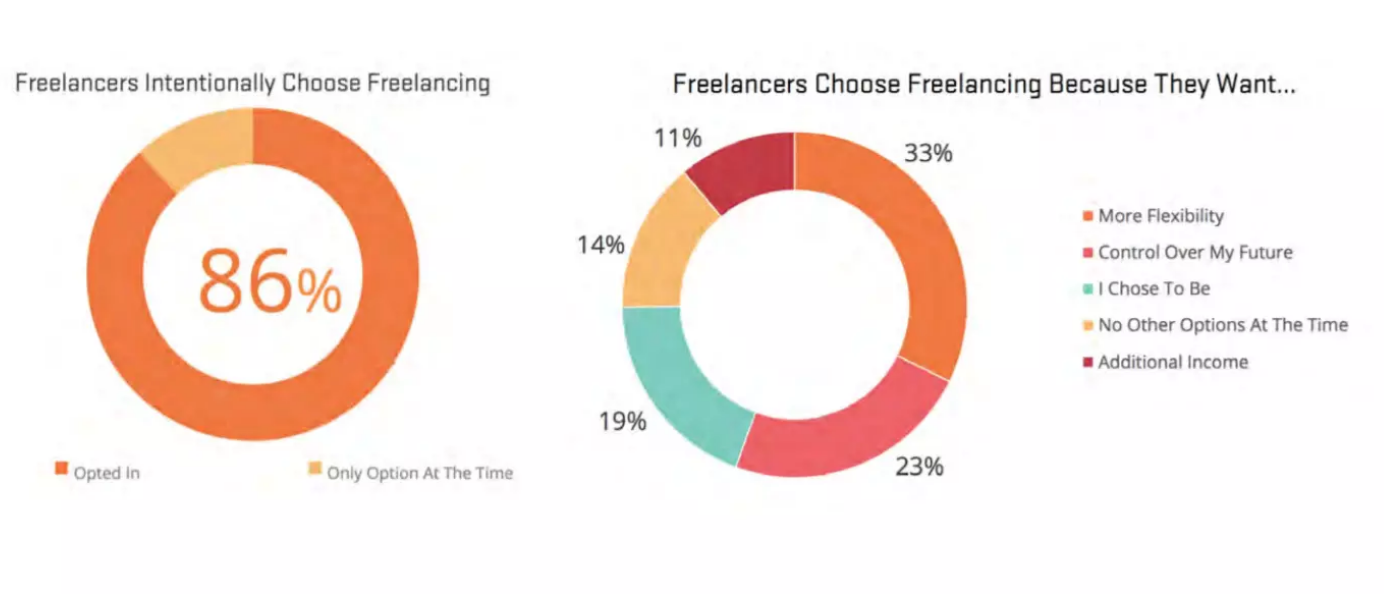
Whichever way you slice it, freelancing has its fair share of negative connotations: work-shy, lazy, above the system, too good for a normal job.
Five years later, things are a little different.
Now people think it’s “cool” (yes, I hate that word too) to freelance, and more and more of the workforce are choosing to go out on their own.
We see all these different depictions of freelancing lifestyles on the TV and internet (I’m willing to bet you’ve already read a ton of freelancing websites before you landed here, right?).
Some of them pimp out the idea that you’ll be earning six figures in no time at all; some feature dark stories of freelancing gone wrong and the endless feast and famine cycle.
You probably have an image of what your freelancing life will look like in your head – and, quite honestly, you can make it look like however you want in reality – but there are a few things that are the same across the board for every freelancer, particularly those who are just starting out.
Organisation and Time Management
The hardest thing about freelancing is there’s no one to hold you accountable except yourself. There’s no one watching over you to make sure you do the work or to check that you’re racking up enough office hours.
This means the task falls fully on you.
You’re the one that needs to set your schedule, to organise your time well enough so you can get everything done and still have time to live your life afterwards.
It’s not mandatory to have amazing time management skills going into it, but you betcha bottom dollar you’re going to have to hone those to perfection with every new project you land.
The Feast and Famine Cycle

People love to talk about the feast and famine cycle when it comes to freelancing.
If you’ve never heard the term before, it basically refers to the idea that you can earn loads some months and absolutely nothing other months.
This is the nature of the beast.
You aren’t always going to have high-paying projects packing out your roster, so it’s important that you plan ahead, save, and manage your money to get you through those no-income months.
Putting Yourself Out There
I’m an introvert at heart and the prospect of freelancing to me meant hiding myself away in my house and never having to speak to anyone ever again.
Boy, was I wrong.
I have to communicate with more people now than in any other job I’ve had before; I have to reach out to potential clients, set up phone calls and talk about sensitive subjects like money, and constantly meet other freelancers.
I’m not saying you need to love putting yourself out there to become a freelancer, but it’s something you’ll have to do more often than you think. So, as long as you’re prepared to do that, you’ll be golden.
Taking Rejection
No one likes getting rejected. Fact.
I remember when I first started applying for freelance jobs and inevitably didn’t get them. I’d really wallow in the rejection for DAYS.
Each time I got a “no” or got ghosted by a prospect, I’d lose a little bit of confidence in my ability to actually make freelancing work.
But then something changed.
I started to build up a hardy barrier towards rejection and just brushed those “no’s” off knowing that it wasn’t anything personal.
It’s vital to do this as a freelancer, otherwise it’s way too easy to fall into the trap of thinking you’re not good enough which – you got it – leads to more rejection.
You might not be numb towards rejection from the outset, but believe me it’s something you’ll get used to pretty quickly.
Commitment
I will be the first to put my hand up and say that I used to be a fully-fledged commitment-phobe (I still am, to some degree). It’s probably what made quitting my 9-5 job so much easier.
When I first started out, I told myself everything was going to be fine because “it didn’t have to be a permanent thing”.
I could always go back to a 9-5 if things didn’t work out.
And, for the first year, I fully ran with this mindset, never fully committing to being a long-term freelancer.
That first year was difficult; I hustled hard to get a consistent stream of clients, but I always placated myself on low-income months with the idea that it wasn’t going to be forever.
But it turned out I LOVED freelancing. I loved setting my own schedule and I wanted to do it forever. I didn’t want to go back to a 9-5 where someone else called the shots.
As soon as I realised that, I committed myself wholly to this freelance thing.
And guess what?
My career blossomed into something I would never have imagined possible.
It’s hard to commit yourself to something that is so unknown, but if you’re going to freelance, you’ve got to dive in headfirst and commit to it fully if you want to see results.
The Benefits of Becoming a Freelancer
Being able to set your own schedule and decide who you client base is going to be are just two of the major benefits of becoming a freelancer.
I shot this video a couple of years ago, but everything I mention in it remains true to this day.
To break it down, the biggest benefits of becoming a freelancer are:
- You get to work when you’re most productive (not everyone works best during the hours of 9 and 5!)
- You get to choose the clients you work for (and say goodbye to those that are shitty!)
- There is no upper earning limit (your salary is literally what you make it)
- It motivates you to be better at what you do and to do better
The Cons of Becoming a Freelancer
On the flipside, there are also some cons of becoming a freelancer that you need to weigh up before taking the plunge.
I’ve already spoken about the feast and famine cycle, but there’s also the prospect of not knowing what you’re going to be doing from one week to the next, and the loneliness aspect of freelancing.
Again, here’s a video I shot a couple of years ago but that still rings true today:
To sum it up, the cons of becoming a freelancer include:
- A potentially unstable income (you often don’t know when the next paycheck will be coming)
- It can get lonely (trust me, this one creeps up on you!)
- Not getting the benefits of a full-time job (I’m talking holiday pay and sick pay here)
- It can be incredibly stressful not knowing what you’ll be doing or where you’ll be in the next week, let alone the next year
If you’re ready to dive in, don’t forget to download your free e-book that goes into that absolute ins and outs of becoming a freelancer – arm yourself with everything you need to become a success!
Figuring Out What To Sell
Freelancing is basically selling a skill or a service so, if you don’t have a skill or service to sell, you’re not going to make it as a freelancer.
If you’re thinking about taking the plunge and kicking out on your own, chances are you already have a skill in mind.
Maybe for your day-job you’re a graphic designer and want to offer that skill to other clients as a freelancer. Maybe you’re pretty good with words and want to try your hand at writing. Either way, you’re going to need to pick one thing to start with.
What about if I have lots of skills and talents?
This is a great question. In fact, when I first started freelancing, I advertised myself as a writer, social media marketer, digital marketer, and anything else I thought I’d be able to do.
While I could do all of these things, I realised quickly that I didn’t like doing all of those things and I was definitely better at some over others.
It’s harder to sell a menu of services because to clients it looks like you don’t really know who you are are what you’re offering. My advice is to start small and offer one service and, if you find you feel limited doing that, branch out from there – not the other way round.
To figure out what to sell in the first instance, think about:
- What skills you already have from previous jobs and things you’ve done in your spare time
- What you enjoy doing
- What there might be a need for out there (for example, you might enjoy collecting stamps and be really good at it, but it’s highly unlikely you’ll be able to make a career out of it)
If you’re not sure if the skill you want to bring to the table is in demand, do a little Google by searching for “your skill” + “freelancer” and see how many others are already selling that skill.

What You Need to Get Started as a Freelancer
Okay, so by now you’re convinced that becoming a freelancer is definitely for you – or, at least, you want to give it a go (woo yeah, congrats!).
Next it’s time to get your ducks in order.
If you want to give yourself the best chance of success at becoming a freelancer, you gotta plan ahead.
1. Legalities
In most places you can’t just start calling yourself a freelancer and start charging people money for a service without telling the tax office.
It’s worth looking up what legalities you need to adhere to as a freelancer in the country or state you live in.
For example, in the UK, you have to register as self-employed with the HMRC and submit a tax return every year to determine your income and expenses.
Usually it’s not a particularly complicated process, but it’s absolutely vital that you do this before you invoice any clients.
2. Put together a website
So many freelancers get so hung up on creating a website they basic paralyse themselves.
I’ve known people who haven’t launched their business in six months because they’re still “tweaking their website”.
For the love of everything, please don’t do this.
Yes, it’s a great idea to have a web presence to send potential clients to, but it doesn’t have to be the greatest website on the internet. A simple one-pager that explains what you do and provides a way for prospects to get in touch with you will do just fine in the early days.
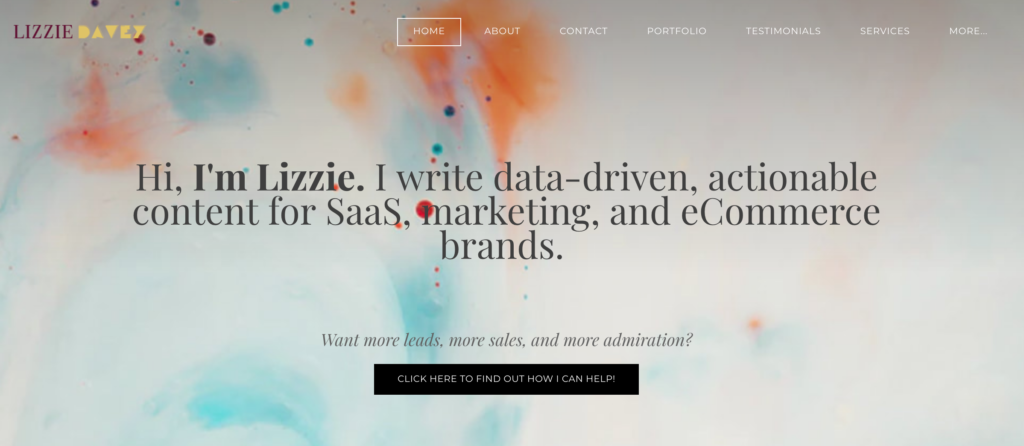
While I know plenty of freelancers who started out without a website, it helps you to look professional and give you the edge over your competitors in the early days.
3. Share a few portfolio pieces
Arrgghh, but I don’t have any pieces to show!
Obviously when you’re just becoming a freelancer, you won’t have any client samples to show, but that doesn’t mean you don’t have anything to show.
Think back to past jobs – have you got any samples you can use from those? What about things you’ve done in your spare time? Or how about creating a couple of samples from scratch just to give potential clients an idea of what you can do for them?
This might mean putting together a couple of fictional logos if you’re a designer, or writing an article or two on a particular subject if you want to be a writer.
4. Make sure you have enough time
Even though I quit my job before I went freelance, this isn’t the route I’d recommend taking.
It worked out for me in the end, but the least stressful way of doing things is to build up your freelance business around your regular day job.
Once you know you’re capable of landing a couple of clients and have done a good job working for them, you can then start thinking about quitting your job to go freelance full-time.
In the interim, it’s really important that you manage your time well: do you have a couple of evenings a week you can work? Can you set aside a morning on the weekend? Are you able to fit an hour in on your lunch break?
How to Find Clients When You First Start Freelancing
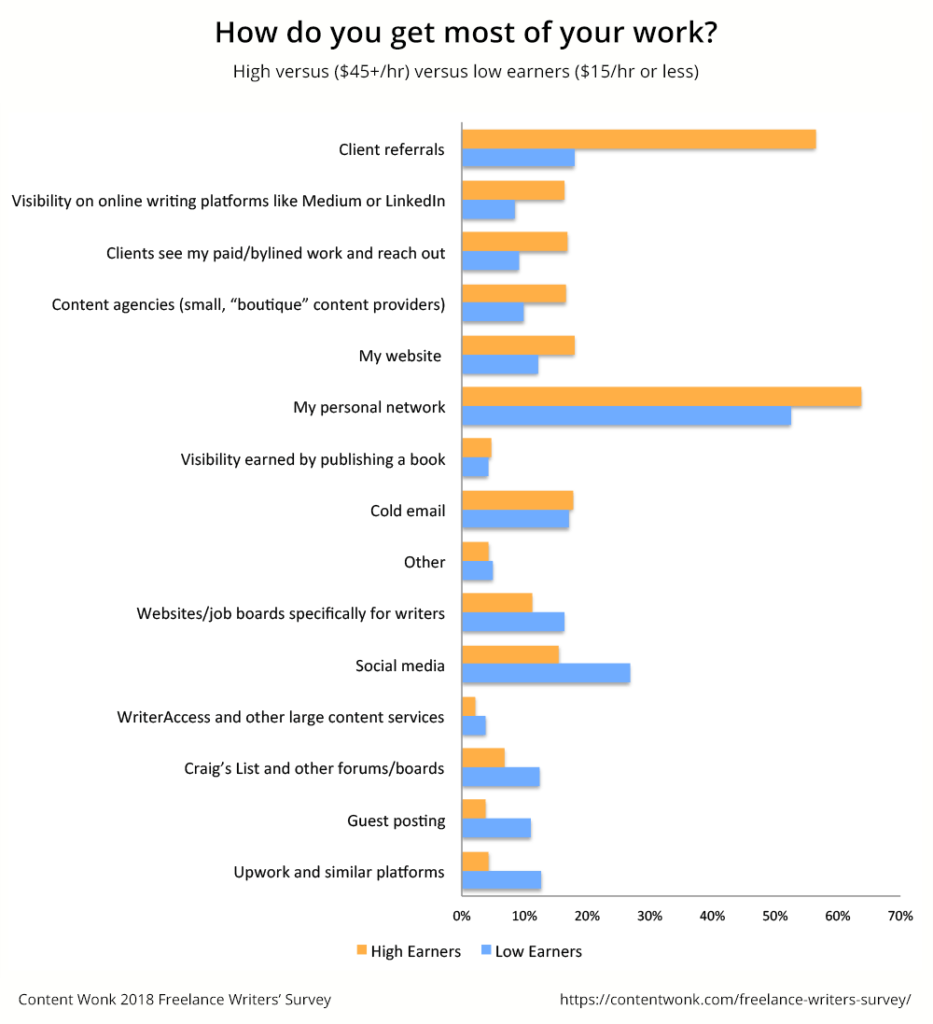
Client referrals are the number one way freelancers get work (and I can vouch for that too – my clients are my best advertisers!), but obviously you don’t have any clients to refer you new work when you’re just starting out.
That means you’ve got to get creative with the ways you look for work.
Here are some ideas to start you off on the right foot:
- Job sites: this is the quickest and easiest way to start applying for jobs because the companies posting here are actively looking for freelancers right away. Check out listings sites like Indeed in your area (type “freelance writer/designer/marketer” into the search bar) to get started
- Cold pitching: this is essentially finding clients you’d like to work for or who you think could use your help and reaching out to them via phone or email to create connections and pitch your services
- Social media: again, this is a great place to make connections with people who might need your service. It’s the long-game of marketing your freelance services, but it’s good to start early. You can also search for “freelance X jobs” in the search bar on social media sites to find jobs that aren’t on listing sites
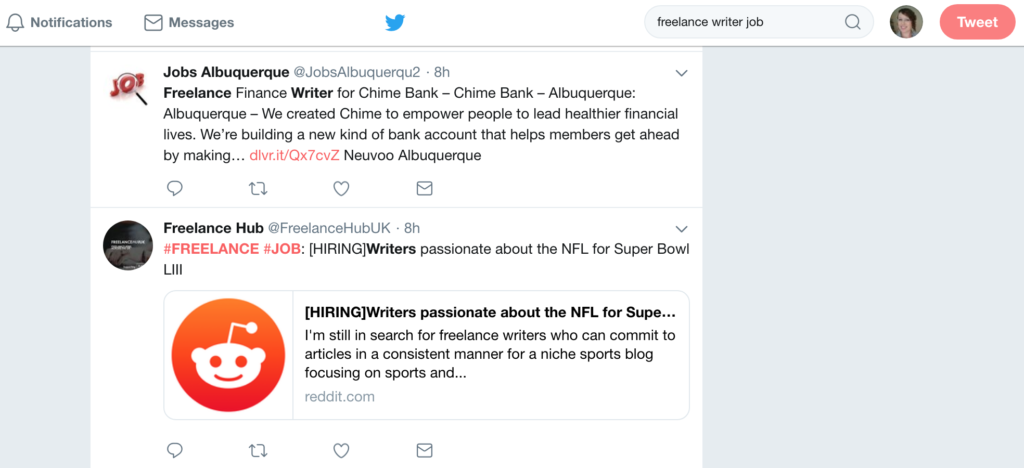
- Content marketing: making yourself more visible will help get the attention of potential clients. This means if you create videos, blog posts, guest post on sites, and generally put fresh content out there consistently, you’re more likely to get yourself on the radar of people who need your help
- Networking: if there’s one thing I’d recommend doing right away, it’s networking. Nothing is as powerful as meeting prospects in-person when you’re just starting out, so check out Meetup.com groups, conferences in your area, workshops, and places where other freelancers and potential clients might be hanging out
Setting Yourself Up for Success
You’ve got everything you need together and you’ve start experimenting with different ways to get clients, so now it’s time to really ramp up that professionalism.
Finding clients is one thing, but what happens when they say “yes!” to your services?
Do you know what to do next?
Don’t freak out if you don’t.
It actually took me almost a year to really figure out my processes once a client decided they want to work with me, and I’m still streamlining them today to make it easier and quicker every time.
Here are some of the things you should be thinking about looking ahead to the future:
The Onboarding Process
What are the next steps you’ll take when a client decides to hire you? What information do you need to give them? What do they need from you?
The onboarding process is the steps you take once you sign up a client, from the initial contact to handing over the finished piece.
Contracts and Payments
How will you get paid? Will you use an intermediary like PayPal or direct bank transfer? And what about contracts?
Contracts are super important in the freelancing world as they protect your back in case things get hairy at any point.
Setting Your Rates
Such a huge topic! Before you start working with clients, you need to have an idea of what you’re going to charge them. Don’t overthink this in the early stages, the main thing is that you’re getting work.
You can always tweak your prices later down the line.
In the meantime, Google other freelancers that are selling a similar service or skill to you and see what kind of prices they’re charging.
Your Future Plan
What does the future look like for you? Do you still want to be freelancing in a year? 10 years? If so, how will you make sure you consistently get work and improve?
Think about whether you want to add any other services to your repertoire, or whether you’d like to branch out at some point in the future by speaking at events or creating a digital product.

Take the Next Steps to Becoming a Freelancer
Becoming a freelancer might seem like a horrendously scary prospect (I royally freaked out when I quit my job and realised I had to make it work), but if you take things step by step, it doesn’t have to be as overwhelming as people make out.
Yes, it’ll be a huge change and there will be good times and bad times, but if it’s something you’re willing to commit to and put in the graft, I have no doubt that you’ll make it a success.
In the meantime, grab your free copy of the Ultimate Guide to Becoming a Freelancer ebook. Inside, there are 80+ pages of step-by-step guides to marketing your freelance business and tutorials for pricing your work in the right way.





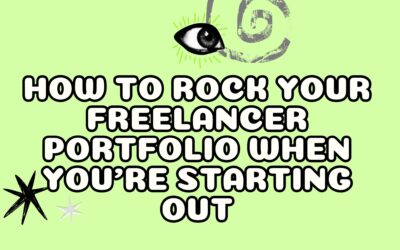
0 Comments